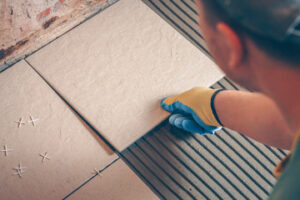If you have been wondering how to repair tile, you have come to the right place. We’ll take you through a few basic steps to help you get started. You’ll learn to remove the grout around the damaged area and apply clear epoxy to the damaged area. In addition, you’ll learn how to protect adjacent tiles from accidental damage.
 When doing tile repair, it is important to clean the grout lines before attempting any repair. Cleaning the lines can be done with a sponge, water, or a vacuum cleaner. While this may seem like an obvious step, it is often overlooked. One of the quickest and most effective ways to remove damaged grout is with the help of a specialized grout saw. This tool is a small, handheld blade that can be used to break up the top layer of grout. Use the saw with steady motions and careful control to prevent damaging the adjacent tiles.
When doing tile repair, it is important to clean the grout lines before attempting any repair. Cleaning the lines can be done with a sponge, water, or a vacuum cleaner. While this may seem like an obvious step, it is often overlooked. One of the quickest and most effective ways to remove damaged grout is with the help of a specialized grout saw. This tool is a small, handheld blade that can be used to break up the top layer of grout. Use the saw with steady motions and careful control to prevent damaging the adjacent tiles.
Another method for removing damaged grout is using a Dremel tool. This can be a time-consuming process. If you are using this technique, be sure to set up a support arm to keep your hands from becoming fatigued. It is also possible to use a hammer and chisel to remove loose tile. Chiseling loose tile may require drilling holes. Once you have removed the loose tile, be sure to protect your work area with a protective covering. You can choose from painter’s tape, drop cloths, or large blankets to cover your appliances. For more complicated tile repairs, hiring a professional may be a good idea. Not only will you be able to be sure that no hidden damage is present, but you will have less to worry about.
Apply clear epoxy to the damaged area. If you are looking for a way to repair a cracked tile, epoxy is an excellent choice. But, before you buy the product, you’ll need to know what to expect and what to do. First, you need to clean the tile. This will remove the dirt, grease, and debris that can get into the crack. You should also wear gloves and a mask to protect yourself. Second, you need to mix the epoxy. Many epoxies are clear, but there are also some that have color. It is best to use the color that matches the color of the tile.
Once you have the epoxy mixture ready, you’ll need to apply it to the damaged area. You can use a toothpick or craft stick to spread it out. Once the epoxy has been applied, you’ll need to let it dry. This can take several hours or a few days. Afterward, you should paint over the epoxy. When you’re painting over the epoxy, you can use a small paintbrush. Apply a thin coat and allow it to dry. Then, brush on a layer of paint that has a similar color to the tile. After it’s completely dried, you can seal the paint with a urethane sealer.
Protect adjacent tiles from accidental damage. When it comes to doing a tile job, it’s not all about nailing down the actual floor tiles, you also have to worry about protecting your venerable floor from the plethora of construction dust that is sure to be floating about. While there is a myriad of ways to go about this task, a few simple safety precautions should be considered. For instance, closing doors to adjoining rooms can be an effective way of keeping your floors out of the hands of your hapless workers. In addition, a few layers of masking tape or adhesive tape can do wonders for this purpose.
To get started, you’ll want to do a bit of homework. First, you’ll need to make a list of tiles that need to be replaced, then you’ll need to come up with a plan for removing the old ones. After that, you’ll need to figure out the best way to do the actual replacement. You’ll need to take into account how many tiles you have to replace, the size of your grout lines, and your overall budget. It’s also a good idea to prepare the space with a protective covering such as a tarp or a heavy duty sheet of plywood.
If you’re doing a major renovation, you’ll also need to consider a number of other safety precautions. For example, if you’re replacing a broken tiling you’ll need to make sure that you’re not using the same tiling tool on the new installation. Similarly, if you’re installing a new flooring material in your home, you’ll need to make sure that you don’t scuff up the walls or knock over the occupants of the adjacent room.
